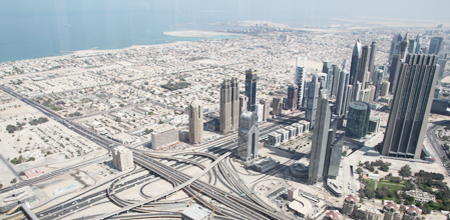Masdar project to complete UAE’s miracle

This spectacular view from the observation deck of Burj Khalifa, the world’s tallest building in Dubai, shows how the city is creating a miracle in the desert. The United Arab Emirates has accelerated its economic development and the amount of land being used for residential, commercial and industrial use has increased dramatically.
The United Arab Emirates is emerging as a key destination for travelers from around the world with year-round sunshine, pristine beaches and spectacular sand dunes.
Such a natural environment, large oil and gas reserves and a cosmopolitan lifestyle make the UAE an excellent place to live and work.
Ever since the establishment of the UAE in 1971 through an agreement among seven Emirates, improvements in infrastructure, such as roads, airports, seaports, housing and telecommunications, have been high on the government’s agenda.
However, high temperatures and low rainfall create harsh conditions. That’s why conservation and protection of the environment is one of the most complex tasks it is facing.
Despite that, the population has grown from around 180,000 in 1968 to around 7 million today. As a result, the amount of land being used for residential, commercial and industrial use has increased dramatically. Reclamation and development have reshaped the UAE’s coastline in a very short time frame.
“I know well about Korea’s rapid economic growth. We created a miracle in the desert as well,” said Mohamed Omar Abdulla, undersecretary of the Department of Economic Development.
In 2009, Abu Dhabi unveiled its 2030 Economic Vision, a two-decade roadmap to transform its natural resources-based economy to one based on knowledge and cutting-edge technology. The government has since initiated various projects to develop the manufacturing, finance, energy, tourism and leisure industries further.

Masdar City
It is now paying attention to protecting the environment, and Masdar City, a clean energy cluster located in Abu Dhabi, illustrates such vision.
Powered by renewable energy, the six-square-kilometer special economic zone provides a test-bed for new technologies. It is now attracting regional and international companies, such as GE, Bayer MaterialSciences, Schneider Electric and BASF, as well as small-and medium-sized enterprises.
Its objective is to demonstrate that an environmentally responsible city is commercially viable. One of the most appealing aspects of the zone is the use of electric buses and other clean-energy vehicles that makes it cleaner and quieter than other modern communities.
There are some reasons why the Abu Dhabi leadership created Masdar.
Its leadership has learned the lessons of traditional desert living, where resource conservation is essential to survival in the harsh environment.
Key goals of the 2030 Vision includes increasing the non-oil share of the economy from 40 percent to more than 60 percent and diversifying the scope of economic activity to various sectors, such as education, banking, finance, tourism and manufacturing.
“We are at the dawn of a global energy revolution that will transform the way we think about power generation, distribution and consumption,” said Jerald Yoo, a Korean professor teaching at Masdar.
“Operating across the full spectrum of renewable energy and sustainable technologies, Masdar is creating an example of how we will live and work in the future.”
One of Masdar’s key features is a solar panel farm, which aims to produce 17,500 megawatts per hour of clean electricity annually, thereby offsetting 15,000 tons of carbon emissions per year. It is equivalent to taking 3,300 cars off Abu Dhabi’s roads.
It is also the test-bed for Personal Rapid Transit (PRT) vehicles. The driverless vehicles are controlled by an advanced navigation system. They use magnets embedded in the corridor to know their position and onboard sensors to detect any obstacles in their path. A wireless connection keeps them linked to a central computer, which guides them on their journey and ensures smooth operation among all vehicles.
At the center of the special district is the LED-lighting tower, which changes colors to let residents and visitors know whether they are using too much energy or whether they are consuming energy at an appropriate level.
The 45-meter-tall tower also captures upper-level winds and carries the wind downward, while mist generators at the top adds additional cooling to the air.
UAE’s participation in Yeosu Expo
The theme of the Yeosu Expo “Living Ocean and Coast” has particular resonance with the UAE, whose coastline, bordering the Arabian Gulf and the Gulf of Oman, exceeds 1,300 kilometers.
Fishing, pearling and trading by sea were the economic base upon which the country developed prior to the discovery of oil in the 1950s.
UAE officials say a baby turtle, which hatched on the Saadiyat beach in 1971 when the UAE was formed, could be returning for the first time to the same beach, to lay her own eggs, in the coming months. That’s because they are slow to mature and some do not lay eggs until they are 50 years old.
The UAE Pavilion to be build for the Yeosu Expo will explore the relationship between humans and the sea in the UAE.
The pavilion will feature interactive booths, called InfoPods, where visitors can choose informative films connected with the UAE’s marine environment. The films are about sharks, dugongs, turtles, mangroves, coral and fisheries.
There will also be the “Ocean of Dreams,” a virtual aquarium where visitors can create their own fish and set them free with a wish. <Korea Times/ Na Jeong-ju>





















































